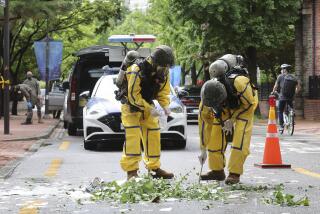The face of South Korea’s boogeyman
Reporting from Namyangju, South Korea — He looks more like a graying clergyman than the boogeyman of thousands of South Korean childhoods.
But Kim Shin-jo is both.
The 69-year-old may preside over a Protestant church in this picturesque community where the Han River bends among mountain peaks. But he is also the reluctant grandfather of North Korean spies, a reminder of a cloak-and-dagger world that refuses to be dispatched to the history books on this divided peninsula.
On a recent day, Kim read a news story about the sentencing of two North Korean military spies. Such stories stir bitter memories of the night in 1968 when Kim and 30 other heavily armed North Korean commandos slipped into Seoul on a mission to assassinate then-President Park Chung-hee.
For the infiltrators, the operation ended in disaster. Cornered outside the presidential residence, they waged a deadly, days-long gun battle with South Korean police and military forces. Although nearly all of the North’s commandos were killed, Kim was captured. Interrogated for months about his spy career, he was eventually released and later became a South Korean citizen, marrying and having a family.
Years in a free society have exposed the fallacy of North Korea’s argument that the South is an agonized wasteland that must be recolonized. Still, Kim feels pity for these newest Northern moles.
“I know they must be punished — we have a rule of law here,” he says. “Still, I’m a human being. I feel sorry for them.”
As the recent U.S. arrest of nearly a dozen Russian agents illustrates, international espionage still exists decades after the Cold War — especially on the Korean peninsula, where North and South are still technically at war.
Without money for high-priced satellites, a cash-starved North Korea relies on a more practical resource.
“It’s hardly believable, but in this high-tech age, North Korea still relies heavily on humans as information gatherers,” said Lee Dong-bok, a former member of South Korean intelligence and a senior associate at the Center for Strategic and International Studies.
Kim, whose parents were executed when he pursued citizenship here, still faces derision over his sinister mission of long ago. He’s not a man of God, some say, but a would-be assassin. He remains haunted for surviving when others didn’t.
“Sometimes,” he says, “I think it would have been better if I had died that day.”
*
The operation code names were Cuckoo and Skylark.
At 27, Kim was chosen from among tens of thousands of North Korean agents to form the elite 124th Special Forces Unit. Their task: Cross the heavily mined DMZ and execute the South Korean president, taking pictures to verify the kill.
The 31 commandos were divided into six teams. As an army lieutenant, Kim led a squad whose role was to take out the bodyguards at the presidential mansion, known as the Blue House.
“I felt gratified to be part of the revolution to emancipate South Korea,” Kim recalls. “We thought the president there was a stooge, an American collaborator. I hated him.”
The unit set off at 8:30 p.m. on Jan. 17, 1968, dressed in South Korean army uniforms. Moving by darkness, hiding during the day, they snipped barbed wire and marched south through the mountains.
One night, they ran into a group of farmers gathering wood. Instead of killing them, they warned the villagers not to report them. The civilians immediately contacted authorities, who launched a manhunt for the infiltrators.
Still, Kim and his teams made it to within 200 yards of the Blue House before being stopped by a suspicious South Korean soldier who demanded their identification.
The commandos opened fire, setting off a series of deadly street battles. Eventually, 35 South Koreans were killed and 64 wounded — soldiers, policemen and civilians, including a 15-year-old boy, who was among the victims of a grenade thrown at a loaded bus.
Insisting that he made a point not to kill civilians, Kim says that he scattered from the rest and never fired his gun. Instead, he fled south into the woods, where he was captured within hours.
Two days later, Kim was trotted out in handcuffs on live television. Asked about his mission, the unrepentant prisoner gave an answer that still haunts many older South Koreans: “I came down to cut Park Chung-hee’s throat,” he declared.
But his revolutionary spirit would not last — thanks to a South Korean army general who headed Kim’s interrogation. Over months of patient reasoning, the officer broke through Kim’s defenses. The two eventually became close.
“He told me, ‘We have a problem with the North Korean regime, not you,’ ” Kim recalls. “He was my father’s age and treated me as his son. He said, ‘I was a young soldier too once. As a commander, I will never kill you. But I will forgive you.’ ”
*
After four decades, the South Korean government recently opened a trail that leads south toward the capital from the North Korean border. It is the path the commandos took on their fatal mission. For years, the winding path has been known as the Kim Shin-jo Route, after a man whose name for many is as recognizable as any former president.
Officials called on Kim to act as a tour guide on the trail’s opening day. He could have refused, he says. But he realized that in order to come to terms with this painful national incident, South Koreans needed to see him in the role of the everyman, to see that he was no longer their boogeyman.
All day, people pointed at him. Those old enough often spoke with scorn. Kim, they swore, was the reason many South Koreans fled their homeland in the early 1970s, fearful of another war with the North. Because of Kim, many of the older generation who remained behind lived in perpetual fear.
“Wherever I go, I get the comments,” says Kim, who became a Protestant clergyman in 1997, finding solace in his faith. “It will happen as long as I am alive. People will point and accuse me.”
Every Jan. 21, Kim memorializes the day of the attack. The day once brought what Kim calls “indescribable pain.” But his wife has taught him to think differently.
“My family tells me that as of Jan. 21, 1968, I was dead,” he says. “On that day, I started a second life. I’m really 69, an old man. But they joke that I’m only 42. And that day that once caused me so much grief should be celebrated as my birthday.”
Ju-min Park of The Times’ Seoul Bureau contributed to this report.
More to Read
Sign up for Essential California
The most important California stories and recommendations in your inbox every morning.
You may occasionally receive promotional content from the Los Angeles Times.











